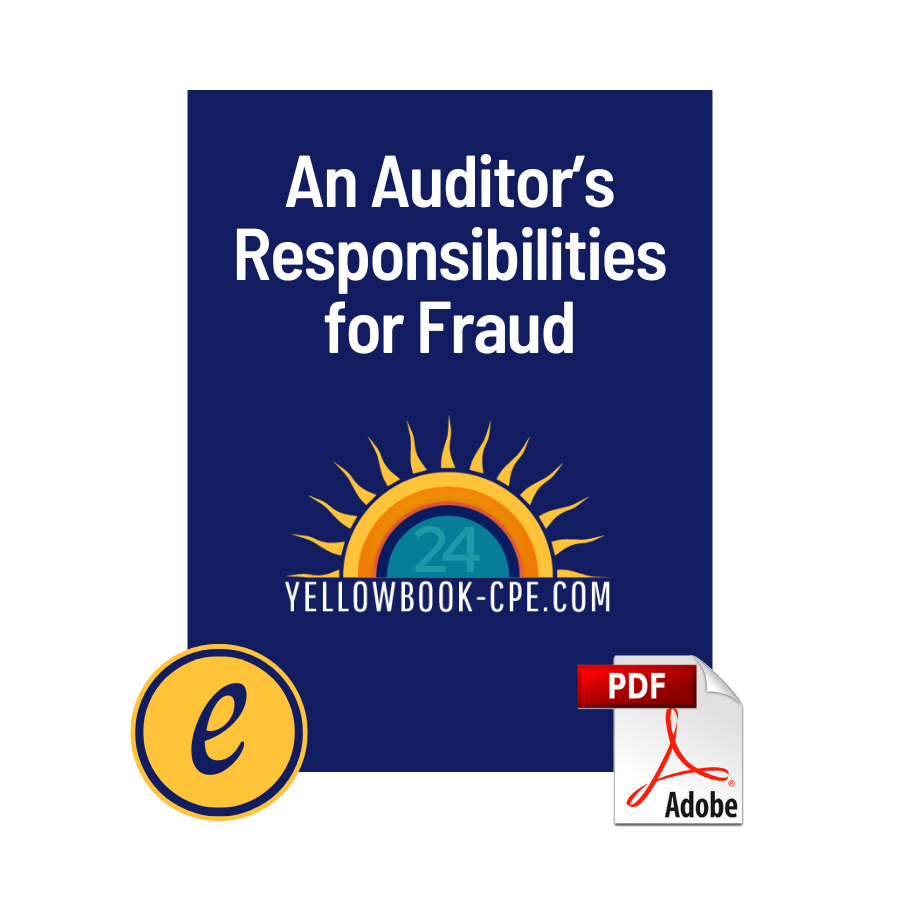Description
An Auditor’s Responsibilities for Fraud in the Government Environment includes a self-study e-book delivered to you immediately upon purchase for 11.5 hours of CPE credit!
The Yellow Book places responsibility on you, as an auditor, to design your audit to detect fraud. But what does fraud look like? What techniques can you use to find it? And how does it rear its ugly head in the government environment?
In this course, we will discuss the taxonomy of fraud as well as how to do your best to uncover it and document your work according to auditing standards. We will also explore recommendations that you can make to your clients to help them avoid fraud in the future.
Course objectives include:
- Differentiate between auditing for fraud in the government environment and auditing for fraud in the commercial environment
- Identify the fraud guidance available to you
- Differentiate between auditors and investigators
- Identify reportable conditions and bad behaviors based on auditing criteria
- Define the due diligence procedures regarding fraud
- Define the meaning of “design audits to detect” fraud relevant to audit objectives for financial audits and performance audits
- Distinguish among your responsibilities for pursuing and for reporting the three reportable conditions
- Define how to ask pointed questions of management, the audit committee, the internal audit director, and front-line staff to unveil fraudulent activities in the workplace under AU-C Section 240
- Identify techniques for easing into the uncomfortable fraud interview
- Define professional skepticism
- Define errors in reasoning
- Distinguish among the three parts of the classic fraud triangle
- Identify common flaws in an organization that provide an opportunity for fraud to occur
- Categorize the three main types of fraud by using the fraud tree
- Distinguish between the four major types of corruption and their subcategories
- Differentiate between schemes to misappropriate cash
- Identify the major types of fraudulent disbursements
- Recognize and name expense reimbursement schemes
- Recognize and name payroll and compensation schemes
- Distinguish between the two major types of inventory misappropriation
- Identify how government financial statements can be fraudulently misstated
- Identify what would motivate a government to misstate their financial statements
- Identify the three major subcategories of nonfinancial fraudulent statements
- Recognize elements of the internet fraud tree
- Identify fraud risks regarding an audit subject using the fraud tree and the audit risk model
- Recognize evidence as physical, documentary, and testimonial evidence, and preserve it for investigators
- Select controls in the workplace to prevent fraud
Program level: Intermediate
NASBA Category of Study: Auditing (Governmental)
Advance preparation: None
Who should attend: Auditors
Prerequisites: One or more years of government auditing experience
Instructional method: Self-study text with online qualified assessment. QAS SS
CPE Credit Hours: 11.5
Author: Leita Hart-Fanta, CPA
This course is also included in the Fraud Bundle.
This course does qualify for the 24 hour Yellow Book CPE requirement.
READ INSIDE THIS BOOK: https://yellowbook-cpe.com/little-frauds-are-a-big-deal-in-government.html
Questions? You can find our FAQ here.
What People Say About This Course
“I love your classes. They are interesting to me and I like that I can understand them better than most other courses that I have taken because you put real life experiences in them.” – CPA
“I will have your list of questions to ask about fraud with my staff. It’s a really nice list.” – CPA in public practice
“I like the examples. It makes the course seem to go by much faster than just reading through a bunch of regs.” – CPA in public practice
“I particularly liked the comparison of the investigator and the auditor. I teach auditing and found many ideas that I can use in my classes.” – College Professor
“The humor throughout was great. Still focused on the material and the world of audit, professional standards, and fraud investigations, but the humor made it much lighter.” – State Agency Auditor
“It helped conceptualize how to keep fraud in mind when conducting audit work and proper steps to take when encountering such incidents.” – State Agency Auditor
“I feel much more aware of all the many types of fraud, which should help improve brainstorming on audits.” – State Agency Internal Auditor
“The course was not dry and had great examples and the way it was written made it interesting and enjoyable.” – Consultant
“It was long, but I wasn’t bored.” – CPA


 Yellowbook-CPE.com is registered with the National Association of State Boards of Accountancy (NASBA) as a sponsor of continuing professional education on the National Registry of CPE Sponsors. State boards of accountancy have final authority on the acceptance of individual courses for CPE credit. Complaints regarding registered sponsors may be submitted to the National Registry of CPE Sponsors through its website:
Yellowbook-CPE.com is registered with the National Association of State Boards of Accountancy (NASBA) as a sponsor of continuing professional education on the National Registry of CPE Sponsors. State boards of accountancy have final authority on the acceptance of individual courses for CPE credit. Complaints regarding registered sponsors may be submitted to the National Registry of CPE Sponsors through its website: